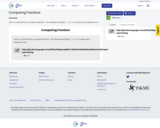
This is a Jamboard to compare fractions. The students will drag <, >, or = to make each statement true.
- Subject:
- Mathematics
- Material Type:
- Activity/Lab
- Author:
- Elsie Owens
- Date Added:
- 05/18/2021

This is a Jamboard to compare fractions. The students will drag <, >, or = to make each statement true.

This lesson is using Jamboard to convert fractions to decimals. Students will write equivalent decimals on sticky notes and place in the square.

In Grade 5 Unit 5, students continue their exploration with fraction operations, deepening their understanding of fraction multiplication from Grade 4 and introducing them to fraction division.
Students began learning about fractions very early, as described in the Unit 4 Unit Summary. However, students’ exposure to fraction multiplication only began in Grade 4, when they learned to multiply a fraction by a whole number, interpreting this as repeated addition. For example, 4×2/3 is thought of as 4 copies of 2 thirds. This understanding is reliant on an understanding of multiplication as equal groups (3.OA.1). In Grade 4, however, students also developed an understanding of multiplicative comparison (4.OA.1), which will be of particular importance to the new ways in which students will interpret fraction multiplication in this unit.
The unit begins with students developing a new understanding of fractions as division. In the past, they’ve thought of fractions as equal-sized partitions of wholes, but here they develop an understanding of a fraction as an operation itself and represent division problems as fractions (5.NF.3). Students now see that remainders can be interpreted in yet another way, namely divided by the divisor to result in a mixed-number quotient. Then, students develop a new understanding of fraction multiplication as fractional parts of a set of a certain size (5.NF.4), which is a new interpretation of multiplicative comparison. Students use this understanding to develop general methods to multiply fractions by whole numbers and fractions, including mixed numbers. Throughout this work, students develop an understanding of multiplication as scaling (5.NF.5), “an important opportunity for students to reason abstractly” (MP.2) as the Progressions notes (Progressions for the Common Core State Standards in Mathematics, Number and Operations - Fractions, 3-5, p. 14). Then, students explore division of a unit fraction by a whole number and a whole number by a unit fraction (5.NF.7), preparing students to divide with fractions in all cases in Grade 6 (6.NS.1). Then, students also solve myriad word problems, seeing the strategies they used to solve word problems with whole numbers still apply but that special attention should be paid to the whole being discussed (5.NF.6, MP.4), as well as write and solve expressions involving fractions as a way to support the major work (5.OA.1, 5.OA.2). Finally, students make line plots to display a data set of measurements in fractions of a unit and solve problems involving information presented in line plots (5.MD.2), a supporting cluster standard that supports the major work of this and the past unit of using all four operations with fractions (5.NF).